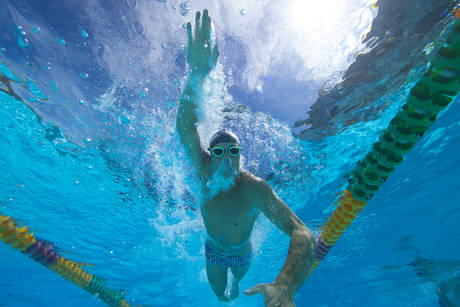
5 Tips to Help Improve Your Swimming Technique
Here are 5 simple tips to enable you to swim for a longer period and enjoy your time in the water.
1) Face in the water – There are a lot of swimmers who don’t actually like to get their head or face wet. They would rather get in and out and not have the hassle of wet hair and water in their eyes. Whilst this may be an enjoyable short term solution, long term it will begin to put added strain and pressure on areas of your body such as your neck, spine, and hips. So, my advice would be to begin to practice putting your face in the water to relax out your body into a horizontal position and to loosen your muscles. You don’t have to do it all of the time, but at least twice in a swim would be a massive support to your swimming and your quality of exercise.
2) Breath Out – We all understand that swimming is a great way to exercise and get fit. What we also need to understand is that a rhythm with your breath needs to be sustained and maintained throughout your swim. By this I mean a rhythmic breath where you are breathing out under water to the same quality and quantity over and over again. That every time your face is in the water your breath out is smooth, consistent and not sporadic or explosive, as this tends to put substantial strain onto your body resulting in the body having to work harder to do the same exercise.
3) Breath In – The quality of the breath in is equally important. The force in which you breathe in will also have an effect on the body in the sustainability of the exercise but also the position your body holds in the water. The best way to explain it is to imagine it like you were walking where your breath is smooth, calm and easy and you’re not breathing erratically. This is exactly what we want to achieve when swimming. Some may want a harder workout whilst swimming but this doesn’t mean that you must speed up your breathing or put pressure on your lungs as you can utilize other parts of your body to intensify your swim rather than compromising the quality of your swim and leaving yourself in a state of exhaustion.
4) Stretch-out your stroke – In swimming there are two elements that support you to physically move forward - your arms are one of them. Whether you are swimming breaststroke, front crawl, backstroke or being super adventurous and going for butterfly, all require you to reach out as far as possible as this action and movement under the water is what is pulling you forward. The further out in front you stretch on top of the water, the more water you are able to push back under water. At the end of the day it is easier to push your hand through air than water so the aim is to create the least amount of resistance as possible.
5) Legs – Are the second element. It’s important that your legs have a constant rhythm. If you are swimming breaststroke the key is to take your time so that each kick has a space or gap in between before the next begins. If you are swimming front crawl there is a constant rhythm that needs to be sustained. At no point does there have to be loads of splashing and noise, the movement isn’t to get attention but to support your movement forward. Keep the legs going small and fast and you will find it will not only work your legs but also core muscles in your body.
The most important thing to remember is that everything is connected and it all stems from your breath. You can’t be moving your arms and legs really well and leave out the breathing or vice versa. Everything has to be sustained as it is supporting the other to move.
Follow these 5 simple tips and your swimming will become a very easy, simple and enjoyable experience.













